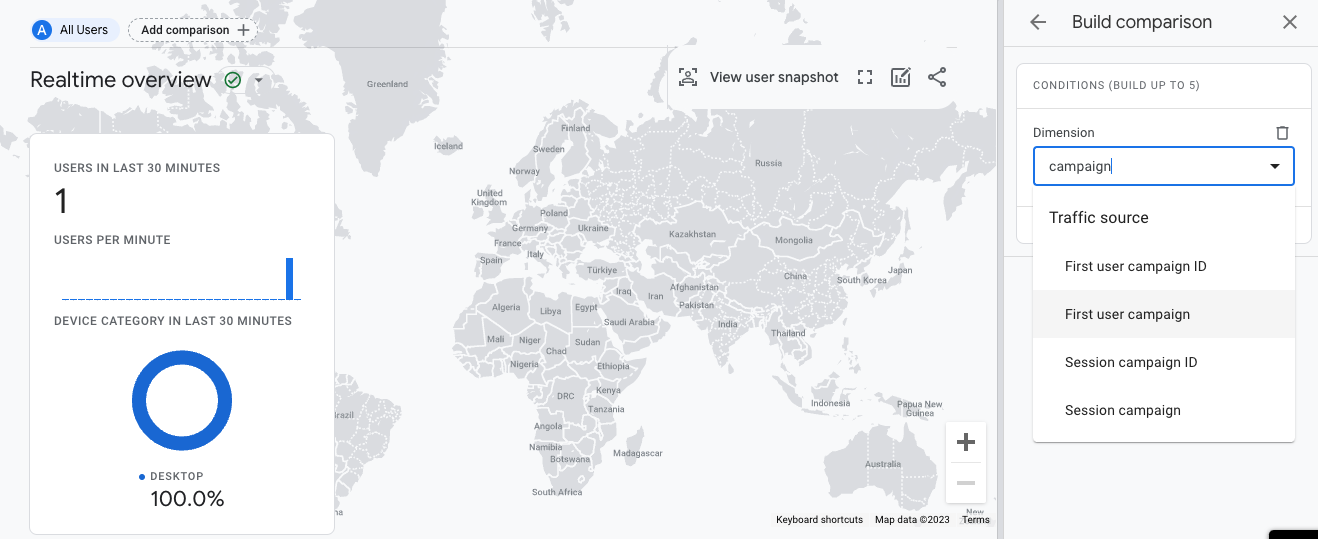How to See UTM Parameters in Google Analytics 4
29 Dec, 2023
Learn how to see and analyze UTM parameters in GA4

Jump to:
Hop on our weekly newsletter train! We're sharing tips so stellar, we're practically job-threatening ourselves!
Navigating the realms of Google Analytics and UTM parameters can feel like embarking on a new year's resolution journey. You know, those annual pledges we all make with the best of intentions, like hitting the gym more or finally understanding what your Gen Z cousin means by "it's lit."
Just like choosing the start of a new year to kickstart a healthier lifestyle, diving into UTM parameters represents a fresh start for your digital marketing strategy. It's about transforming from the 'old' you, who may have been shooting marketing arrows in the dark, to a 'new' you, precisely tracking the performance of each campaign.
UTM parameters in Google Analytics are kind of like you your gym for data fitness. They tone your marketing strategies and flex the muscles of your campaign tracking. With them, you’re not just hoping your digital efforts pay off; you’re actively sculpting and refining them based on solid, actionable data.
So, let's lace up our sneakers, grab a metaphorical bottle of water, and start this journey toward understanding UTM parameters. It's time to approach your marketing goals not by avoiding the complexities of data but by embracing them, transforming 'resolution' into 'evolution'.💪📊
How UTM Parameters Work
UTM parameters are the secret ingredients in the recipe of digital marketing analytics. They are added to the end of your URLs, and like a skilled chef knows just the right spices to use, a savvy marketer knows which UTM parameters to apply for the best results. These parameters typically include source, medium, campaign, term, and content, each offering a unique taste of data.
Source is like the main ingredient, telling you where your traffic originates, be it Google, a newsletter, or a social media platform.
Medium is akin to the cooking method, revealing how your visitors got to you — whether through organic search, paid ads, or email marketing.
Campaign is the recipe name, identifying the specific campaign or promotion driving the traffic.
Term is like a specific seasoning, detailing the keywords used in a paid search campaign.
Content is the garnish on top, differentiating similar content or links within the same ad.
By mixing these UTM parameters into your URLs, you're not just serving up plain data; you're dishing out rich, flavorful insights into your traffic's behavior. It's like turning a bowl of plain oatmeal into an Instagram-worthy breakfast bowl, complete with a drizzle of honey and a handful of berries. Each parameter adds a layer of understanding, allowing you to see not just who's coming to your site, but how and why they're arriving.
UTM parameters are your taste-testers, letting you know which parts of your campaign are tantalizingly successful and which need a little more seasoning. They help you fine-tune your marketing efforts, ensuring that every campaign you cook up is a hit with your audience. 🍽️
Considerations When Setting Up UTM Parameters
Setting up UTM parameters isn't just about slapping on tags willy-nilly; it requires a dash of strategy and a sprinkle of foresight. Think of it as a game of Scrabble. You need to choose your tiles (parameters) wisely to score big (gain valuable insights). Here are some key considerations to keep in mind:
Consistency is Key: Just like in baking, consistency matters. Use a standard naming convention for your parameters. If you start with “utm_source=Facebook,” don’t switch to “utm_source=FB” mid-way. It’s like measuring flour with a cup one day and a spoon the next – it just won’t give you the results you want.
Meaningful Naming: Choose names that are clear and descriptive. “utm_campaign=spring_sale” is far more informative than “utm_campaign=ss123.” It’s like labeling spices in your rack; 'smoked paprika' is more helpful than 'red powder.'
Avoid Redundancy: Ensure that each parameter offers unique information. If your medium and source are both set to ‘Facebook’, it’s like having two identical spices on the rack - it doesn’t add value.
Keep it Short and Sweet: While descriptive, your UTM parameters shouldn’t be overly long or complex. It’s a URL, not a novel. Aim for succinct yet informative tags.
Encode Special Characters: URLs don’t play nice with all characters. Spaces, ampersands, and other non-alphanumeric characters can break your URL, so encode them to ensure smooth sailing.
Use a UTM Builder: To avoid human errors (like typos or inconsistent formatting), use a UTM builder. It’s like using a food processor instead of chopping by hand – faster, easier, and more consistent.
Document Your Parameters: Keep a record of your UTM parameters. This helps maintain consistency across your team and over time. It’s like keeping a recipe book for your favorite dishes.
How to See UTM Parameters in Google Analytics 4
Let's discuss how to track these breadcrumbs in your GA4 account.
Understanding UTM Dimensions in GA4:
UTM parameters correspond to dimensions in GA4.
Look for session-scoped dimensions such as “session source/medium” or “session campaign” in GA4. These describe data at the session level and have the prefix “session” in their name.

GA4 also features user-scoped dimensions showing the same UTM parameters as the session-scoped ones; these give insight into the UTM parameters that drove a specific user's behavior.
First User Dimensions and Their Significance:
User-scoped dimensions showcase UTM data from the first user visits only.
This means they display the UTM data from the initial visit of a user, irrespective of subsequent UTM-coded links they click.
How to Test UTM Codes in GA4:
To test UTM codes, clear your browser cookies to start as a 'new user'.
Visit your site using a UTM-coded URL and then check the “Realtime” report in GA4, selecting “First user campaign” as your dimension.

How to View and Analyze UTM Performance in GA4:
Navigate to the “Traffic acquisition” report in GA4.
Customize the primary dimension to show traffic tagged using the utm_campaign parameter.
Add a secondary dimension like “session source / medium” for more detailed analysis.

How to Filter UTM Data for In-Depth Insights:
Apply filters in your GA4 reports to isolate specific UTM-tagged traffic, like email or social media campaigns.
Utilize dimensions like “Session manual ad content” to get granular data on specific campaign elements, such as individual email links or social media ads.
How to Optimize Campaigns with UTM Data Insights:
Harnessing UTM data is like unlocking a treasure trove of insights that can supercharge your marketing campaigns. It's not just about collecting data; it's about using it to make informed decisions that can significantly amplify your marketing efforts. Let's explore how you can use UTM data to optimize your campaigns.
Refining Audience Targeting:
Example: Let's say your UTM data reveals that a significant portion of traffic coming from a specific source, like LinkedIn, has a higher engagement rate. This insight can prompt you to allocate more budget towards LinkedIn ads or tailor content specifically for that audience.
Enhancing Content Strategy:
Consider a scenario where UTM tracking shows that blog posts shared on Twitter lead to more sign-ups compared to other platforms. This could indicate that your Twitter audience resonates well with educational content, guiding you to boost your content marketing efforts on Twitter.
Ad Creative Optimization:
If UTM parameters indicate that certain ad creatives or messages perform better, you can tweak your ad strategy accordingly. For instance, if ads with a humorous tone have higher click-through rates, it might be time to add a little more humor to your ad copy.
Improving Landing Page Effectiveness:
Imagine your UTM data shows that visitors from Facebook ads spend less time on your landing page compared to organic search visitors. This could signal the need to make your landing page more relevant or engaging for the Facebook audience.
Budget Allocation and Bidding Strategies:
UTM data can be a guiding light for where to put your money. If certain campaigns or sources consistently show higher ROI, it makes sense to increase your investment in those areas.
A/B Testing Insights:
Use UTM data to gauge the performance of different variables in your A/B tests. For example, if you're testing two different email subject lines, UTM tracking can show which one leads to more website visits or conversions.
Identifying New Opportunities:
Sometimes, UTM data can uncover surprising trends or new niches. If you notice a surge in traffic from an unexpected source or demographic, it might open up new avenues for targeting.
Seasonal and Time-Based Adjustments:
UTM data can reveal patterns in user behavior based on time or season. This can be invaluable for planning time-sensitive promotions or content.
Feedback Loop for Continuous Improvement:
Continuously monitor UTM data and adjust your campaigns accordingly. It's an ongoing process of tweaking, testing, and optimizing.
Conclusion
UTMs are more than just tracking tools; they're the breadcrumbs that lead you to a deeper understanding of your audience's behavior, preferences, and engagement patterns. By leveraging these insights, you can tailor your strategies to resonate more effectively with your target audience, ensuring each marketing dollar is spent wisely and each campaign hits its mark.
Whether you're looking to refine your current campaigns or embark on new marketing adventures, our team is here to guide you through the maze. Don't leave your marketing success to chance; take control with a data-driven approach.
🌟 Ready to unlock the full potential of your marketing efforts? Grab your free marketing plan today and embark on a journey to marketing mastery with DriftLead. Navigate to DriftLead's Free Marketing Plan and let's chart the course to your success together! 🚀🎯






